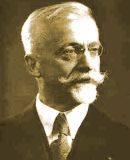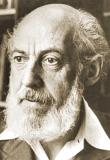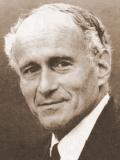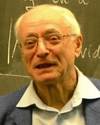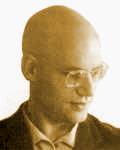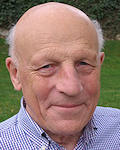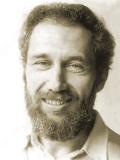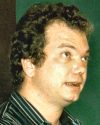The Many Faces of Nicolas Bourbaki
The French Ecole
Normale Supérieure (ENS) has a tradition for pranks.
One such prank was a
fake lecture
given in 1923 to the 21 entering students
(including Paul Dubreil and future Bourbakists Henri Cartan,
Jean Coulomb and René de Possel)
by Raoul Husson
(1901-1967, ENS 1921) an older peer wearing a false beard to impersonate
a distinguished venerable mathematician billed as "professeur Holmgren".
The lecture presented a series of fake results from
fictional mathematicians named after famous French generals,
culminating in Bourbaki's theorem
(named after General Charles Bourbaki,
1816-1897). That's how some future ENS alumni took note of the Bourbaki name.
According to André Weil (1992) the
moniker Nicolas was picked by his future wife
Eveline de Possel, who was then still married to
fellow founder René de Possel (1905-1974).
One of the most famous mathematics textbooks of all time was
Cours
d'analyse mathématique by
Edouard Goursat
(1858-1936; ENS 1876). The first edition was published in two volumes
(1902,1905). The second edition was published in three volumes (1910-1913)
which were later updated once or twice (most recently in 1924, 1925 and 1923, respectively).
Goursat is credited to be the first person who noticed how Stokes' theorem could be very
beautifully generalized using differential forms, as shown below.
Stokes' theorem actually generalizes the
fundamental theorem of calculus.
It was first proved by Poincaré
(1899) well before
Georges
de Rham (1903-1990) put forth a conceptual frame (1931).
The need for a full elucidation was such a key preoccupation of some Bourbaki founders
that it's not an exaggeration to state that
Nicolas Bourbaki and this general result are significantly due to each other...
Some Incarnations of Stokes' Theorem
| Gradient Conservativity |
| ò |
b
a |
grad f . dM
=
f(b) - f(a)
|
|
| Kelvin-Stokes' Formula |
òòS rot U . dS
=
òC U . dM
|
| Ostrogradsky's Theorem |
òòòV
div U dV
=
òòS U . dS
|
The birthdate usually quoted for the group which would become known as
Nicolas Bourbaki is the date of their second formal
meeting (1935-01-14).
They had already met one month earlier
(1934-12-10)
and several other preliminary meetings had not been formally
recorded at all.
The prospective founders were talented young French mathematicians who were all alumni from
ENS,
with the sole exception of
Szolem Mandelbrojt (1899-1983).
The first Congrès Bourbaki took place from 10 to 20 July 1935
at the Station biologique universitaire in the medieval city
of Besse in central France (called
Beça in Occitan) which was recognized as
a free town in may 1270 and officially named
Besse-en-Chandesse between 1961-04-02 and 1973-07-01, when it merged with
Saint-Anastaise to become part of
Besse-et-Saint-Anastaise.
The name Besse-en-Chandesse is still used on some road signs, road maps
and touristic guides. It's where the ski resort marketed as
Super Besse is located.
On 2003-07-12,
a plaque was unveiled outside the building housing the meeting room identifying it
as the birthplace of Nicolas Bourbaki.
That event followed a conference by
Christian Houzel, attended by a crowd of about 120 mathematicians.
It was the brainchild of Paul-Louis Hennequin (Ulm, 1949)
on behalf of the mathematical department of the
Blaise Pascal University
which had been owning the building since 1901.
Hennequin is the son of Aimé Hennequin,
from Taupe Laplace.
Their initial ambition was to put together (within six months) a much-needed
Analysis textbook to replace Goursat's Cours d'Analyse.
They already had a preliminary agreement with
Hermann to publish it.
As André Weil would later recall,
one key point was the aforementioned urge to elucidate the general validity of the
above formula (Stokes Theorem)
which unifies great results of vector calculus.
However, that sparked a search for rigorous settings which would delay by many years the
publication of the final presentation by Bourbaki of that particular topic...
Eventually, they ended up putting on a fresh solid foundation the entire mathematical knowledge
of their time. This took the form of a collection of books entitled
Eléments de Mathématique (note the militant use of the grammatically
incorrect singular form of mathématiques).
The Bourbaki collaboration has been extremely influential in France and elsewhere.
Bourbaki brought about new rigor based on the
logical foundations of mathematics
(along the way, they also became instrumental in some controversial reforms of mathematical education,
dubiously known as New Math in the US).
This
can be traced to a 1952 meeting
(in Melun, France) between
Swiss psychologist Jean Piaget (1896-1980),
Bourbakist
Jean Dieudonné (1906-1992)
and two other leading mathematicians concerned with education reform,
Gustave Choquet (1915-2006) and
André Lichnerowicz (1915-1998).
The active founding members of the Nicolas Bourbaki group
were:
The official list of founders includes four members who were less active,
namely:
Szolem Mandelbrojt was the uncle and early mentor of the mathematician
Benoît Mandelbrot
(1924-2010;
X1944) of fractal fame.
Two other mathematicians had been present at preliminary meetings,
before the actual foundation of the Bourbaki group:
Thus, the number of Bourbaki founders can be argued to be
5, 9 or 11.

Other noted bourbakists, who joined the group later, include:
- Charles Pisot (1910-1984; ENS 1929).
- Claude Chabauty (1910-1990; ; ENS 1929).
- Frédéric Roger (1910-1984; ENS 1930).
Oflag XVII A (1940-1945).
- Samuel Eilenberg (1913-1998)
Category Theory (1950 to 1966; age 53).
- Laurent Schwartz (1916-2002; ENS 1934). Theory of Distributions,
1944.
- Jean-Louis Koszul
(1921-2018; ENS 1940).
- Pierre Samuel (1921-2009; ENS 1940).
- Roger Godement (1921-2016; ENS 1940).
- Topologie algébrique et théorie des faisceaux (1964,1973).
- Armand
Borel (1923-2003) Swiss bourbakist
from 1949 to 1973.
- Jacques Dixmier (b. 1924; ENS 1942). From 1949.
- John T. Tate
(1925-2019) USA.
Abel Prize in 2010.
- Jean-Pierre Serre (b.1926; ENS 1945). 1949-1973.
1st Abel Prize (2003).
- Serge Lang (1927-2005) Algebraist.
- Alexander Grothendieck (1928-2014). From 1955.
- François Bruhat
(1929-2007; ENS 1948).
From 1954. Bruhat-Tits Theory.
- André Martineau (1930-1972; ENS 1949)?
- Pierre Cartier (1932-2024; ENS 1950) bourbakist
from 1955 to 1983.
- Hyman Bass (b. 1932).
- Adrien Douady (1935-2006; ENS 1954).
- Jean-Louis Verdier (1937-1989; ENS 1955).
- Michel Demazure (b. 1937; ENS 1955).
-
Michel Raynaud (1938-2018; ENS 1958).
- Luc Illusie (b. 1940; ENS 1959).
- Louis Boutet de Monvel (1941-2014; ENS 1960). From 1971 to 1991.
- Bernard Tessier (b. 1945).
- Alain Connes (b. 1947; ENS 1966).
- Arnaud Beauville (b. 1947; ENS 1966).
- Daniel Bennequin (b. 1952; ENS 1972).
- Guy Henniart (b. 1953; ENS 1973).
- Joseph Oesterlé (b. 1954; ENS 1973).
- Gilles Lebeau (b. 1954; ENS 1974)?
- Georges Skandalis (b. 1955; ENS 1975).
- Jean-Christophe Yoccoz (1957-2016; ENS 1975). Briefly, around 1995.
- Gérard Ben Arous (b. 1957). ENS Ulm, 1977.
- Pierre Julg (b. 1959). ENS Ulm, 1977.
- Olivier Mathieu (b. 1960?). ENS Ulm, 1980.
- Patrick Gérard (b. 1961). ENS Ulm, 1981.
- Marc Rosso (b. 1962?). ENS Ulm, 1982.
- Antoine Chambert-Loir (b. 1971). ENS Ulm, 1990.
- Francis Brown (b. 1977). ENS Ulm, 1999. [Current member?]
The guideline is that all members should retire from the group at the age of 50
(Grothendieck and Lang left early, in anger).
Almost all of the above are retired.
It was never a strict rule,
but the level of enforcement is difficult to evaluate because the exact duration of
a member's tenure was rarely made public.
Samuel Eilenberg (1913-1988)
prophet of Category theory, retired at 53.
Rumor has it that a coconutization procedure was used,
inspired by an urban legend about tropical tribes:
When the fitness of the chief is questioned, he has to climb on top of a coconut tree
and the whole tribe attempts to shake him down.
If he doesn't fall, then he's deemed to be still fit for his functions.
The mathematical counterpart of that is to throw some utter nonsense during a meeting.
If the unsuspecting target of the coconutization fails to detect it,
then the age-rule will be enforced and he won't get invited to the next meeting.
Nobody has to be rude about it (kinda).
This was told by
Vladimur Arnold (1937-2010) of
KAM fame,
who was never a Bourbakist himself. I heard the same story from a
good friend
who's a former classmate of Alain Connes.

The semi-mandatory retirement rule was instigated by Weil as the founding members
were near the critical age: A letter from him proposing a
gradual disappearance of the founding members was
read by Cartan during the Summer conference of 1956,
at the end of a lunch for Dieudonné's fiftieth Birthday (1956-07-01).
It was a drastic way to incite the more recent members to take on full responsibility.
A necessary condition for the group's planned immortality.
According to Jean Dieudonné
(interviewed on 1987-06-12)
one of the motivations for the age rule was that many mathematicians seem overly enamored
with what they learned when they were young. The founders wanted the
group to remain forever receptive to new ideas.
Retired members were not entirely cut off from active members as they continued
to receive the internal newsletter La Tribu (The Tribe)
containing the proceedings of the meetings.
(Tribe is what the original group liked to call itself.)
Pierre Cartier said that, during his own tenure from 1955 to 1983,
the Bourbaki group was holding three yearly meetings (for a total of about one month per year).
Part of the preliminary recruitment of new Bourbaki members was to invite them to
one of those meetings. Sir Michael Atiyah
went to a single meeting as a prospect but decided he didn't like the Bourbaki
working style. Only one person who was not formally a member of Bourbaki
ever took part in writing up pieces which were eventually published under
the Bourbaki name (after many revision by several members, as usual):
Paul-André Meyer
(1934-2003; ENS 1954). This case is so unique that some notorious Bourbaki members
thought he had been formally inducted, but this ain't so
(video).
The (nonprofit) Association formally
incorporated in 1952 seems alive and well,
although it's not nearly as active and/or influential as it once was.
At one point, there were concerns that the volumes published in 1983 and 1998
would be the last ones of the collection.
However, one major update was published in 2016.
|

